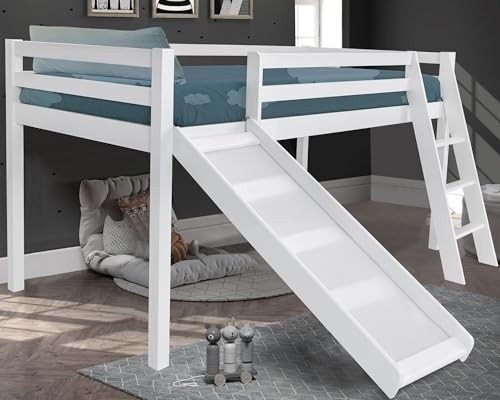A Comprehensive Guide to Children's Bunk Beds: Styles, Benefits, and Safety Considerations
Bunk beds have become a popular option for households seeking to optimize space and provide a fun sleeping environment for kids. With their unique style, they offer an innovative and practical option for shared bedrooms, playrooms, or perhaps guest lodging. This short article explores the different designs of kids's bunk beds, their advantages, safety considerations, and addresses some frequently asked concerns.
The Allure of Bunk Beds
Children's bunk beds are more than just space-saving structures; they are likewise a gateway to daring dreams and imaginative play. Below is a comprehensive examination of their many benefits.
Benefits of Bunk Beds
- Space-Saving: Bunk beds effectively make use of vertical space, making them a perfect option for smaller sized rooms.
- Lively Design: Many bunk bed styles consist of slides, camping tents, and themed aspects, stimulating imagination and excitement.
- Partner Sharing: Bunk beds are perfect for brother or sisters sharing a space or accommodating sleepovers.
- Flexible Use: Some models can be separated into 2 specific beds, offering flexibility as kids grow.
- Storage Options: Many bunk beds include integrated drawer storage or shelves, even more improving their usefulness.
Designs of Children's Bunk Beds
The variety of bunk beds offered today accommodates different preferences and needs. Below is an overview of some popular designs.
| Design | Description | Best For |
|---|---|---|
| Standard Bunk Bed | A conventional style featuring one bed stacked above another. | Brother or sisters sharing a room. |
| Loft Bed | Comparable to a bunk bed without the bottom bunk, enables for an office or play location listed below. | Limited space for play/desk. |
| L-Shaped Bunk Bed | Two beds organized in an L-shape, typically with extra areas for storage or play. | Unique room layouts. |
| Twin Over Full | A twin bed over a complete bed, accommodating various sleep requirements. | Growing children and teens. |
| High Sleeper | Stands even greater than a loft bed, typically featuring a desk or play location listed below. | Older kids needing more play/desk space. |
| Camping Tent Bunk Bed | Bunk beds with a canopy or tent-like structure, producing a relaxing, enjoyable space. | Active and creative children. |
Key Features to Consider
When picking the right bunk bed for kids, the following functions deserve considering:
- Material: Bunk beds can be made from wood, metal, or a mix. Each has its distinct visual and durability.
- Weight Capacity: Always confirm the weight limitation of the bunk bed to guarantee it can accommodate your children securely.
- Security Rails: Ensure the top bunk has durable rails to prevent falls.
- Ladder Security: A well-designed ladder should use simple and safe access to the upper bunk.
- Completing: Ensure any finishes are non-toxic and safe for children.
Security Considerations
Safety is critical when it concerns children's bunk beds. The following standards need to be abided by:
- Age Appropriateness: Generally, kids under 6 years old need to not sleep in the upper bunk due to security dangers.
- Tough Construction: Ensure the frame and products are strong and can support the weight without sagging.
- Routine Maintenance: Periodically examine for loose screws, bolts, or other components that might require tightening up.
- Clear Play Area: Keep the area around the bunk bed without toys and obstacles to reduce tripping threats.
Setting Rules for Safe Use
Establishing standards for bunk bed use will help guarantee safety:
- Limit Jumping and Climbing: Children ought to be advised against jumping from the top bunk and climbing up on the sides.
- Supervising Sleepovers: Monitor young visitors while they are utilizing the bunk bed for the first time.
- Inform on Ladder Use: Teach how to use the ladder safely, stressing the value of facing the ladder when going up or down.
Often Asked Questions
1. What Bunk Bed Sale tituswegner.top is proper for a child to oversleep the leading bunk?
Most makers suggest that children must be at least 6 years of ages to oversleep the upper bunk. This guideline is designed to mitigate the risk of falls.
2. Can bunk beds be tailored?
Yes, many makers provide customizable options, consisting of colors, materials, and additional features like drawers or desks.
3. Are bunk beds safe for weight?
Bunk beds have weight limitations, generally varying from 200 to 400 pounds, depending upon the design and material. Constantly examine the manufacturer's requirements.
4. How do I maintain and clean up a bunk bed?
Regularly look for loose parts, keep the bed clean by cleaning down surfaces, and ensure the bed linen is fresh to promote a safe and hygienic sleep environment.
5. Can bunk beds be separated into individual beds?
Many bunk beds come with an alternative to separate them into 2 private beds, providing long-term versatility.
Children's bunk beds are more than simple furniture; they are a practical, versatile, and creative element of a kid's space. With different styles available and many safety considerations to keep in mind, parents can pick the ideal bed that fits their space, fulfills their children's needs, and imparts a sense of experience. By understanding the benefits, styles, and safety measures connected with bunk beds, families can produce a delightful and protected sleeping environment for their kids. Whether for brother or sisters sharing a space or space-saving options, bunk beds remain a precious option for lots of homes.

